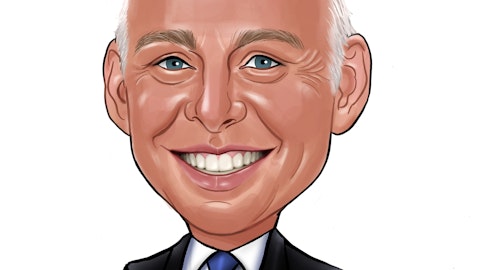Both small- and large-scale investors continue to seek bargains in the energy industry, as energy stocks have plummeted significantly over the past year or so due to depressed crude oil prices. There is mounting evidence that the crude oil market is in a bottoming out phase at the moment, but it is hard to stipulate when the industry will embark on a real turnaround. In fact, short sellers are shorting energy stocks at an extremely high rate at the moment, which almost equals the rate of short interest bank stocks were experiencing during the recent financial crisis. Short interest in energy stocks reached the third-highest level of any sector since 2007. Nonetheless, bargain-hunting investors could pinpoint bountiful investment opportunities in the energy sector, which will definitely embark on a turnaround sooner or later. For that reason, the Insider Monkey team decided to take a look at the most loved energy stocks among hedge funds as of the end of the fourth quarter of 2015. It is highly likely that this list of five most loved energy stocks comprises companies with strong balance sheets and strong liquidity, so let’s take a look at these allegedly five high-potential energy stocks.
While there are many metrics that investors can assess in the investment process, hedge fund sentiment is something that is often overlooked. However, hedge funds and other institutional investors allocate significant resources while making their bets and their long-term focus makes them the perfect investors to emulate. This is supported by our research, which determined that following the small-cap stocks that hedge funds are collectively bullish on can help a smaller investor beat the S&P 500 by around 95 basis points per month (see more details here).
5. Halliburton Company (NYSE:HAL)
– Investors with Long Positions (as of December 31): 53
– Aggregate Value of Investors’ Holdings (as of December 31): $2.56 Billion
The number of hedge funds tracked by Insider Monkey with positions in Halliburton Company (NYSE:HAL) dropped to 53 from 59 during the final quarter of 2015, while the value of those positions shrank to $2.56 billion from $3.77 billion quarter-on-quarter. These 53 funds accumulated nearly 9% of the company’s outstanding common stock on December 31. The shares of the provider of services and products to the upstream oil and natural gas industry are down 3% year-to-date. Just several days ago, the diversified energy services company announced a headcount reduction of 5,000 employees, which accounts for 8% of its global workforce. The company cut its global headcount by roughly 25% during 2015 in an attempt to reduce its cost structure to tackle the worsening market conditions. Halliburton generated $23.6 billion in revenues during 2015, which marked a decrease of 28% year-on-year. More importantly, its revenue in North America declined by 39% year-over-year. Andreas Halvorsen’s Viking Global acquired a new stake of 6.67 million shares in Halliburton Company (NYSE:HAL) during the December quarter.
Follow Halliburton Co (NYSE:HAL)
Follow Halliburton Co (NYSE:HAL)
Receive real-time insider trading and news alerts
4. Pioneer Natural Resources (NYSE:PXD)
– Investors with Long Positions (as of December 31): 57
– Aggregate Value of Investors’ Holdings (as of December 31): $4.07 Billion
There were 57 smart money investors from our database with stakes in Pioneer Natural Resources (NYSE:PXD) at the end of December 2015, which accumulated 21.70% of the company’s total outstanding shares, as compared with 58 registered at the end of the third quarter. Meanwhile, the aggregate value of long positions declined by approximately 4% quarter-on-quarter to $4.07 billion. The independent oil and gas exploration and production company primarily focuses on its operations in the Spraberry/Wolfcamp oil field in West Texas, which has an estimate remaining productive life of more than 40 years. The Spraberry/Wolfcamp field accounts for 70% of the company’s total proved oil and gas reserves. In the meantime, Pioneer Natural’s 2016 capital budget amounts to $2.0 billion, with $1.85 billion to be channeled to drilling operations and $150 million to vertical integration, buildings, and other additions. The company’s management anticipates that net cash flows from operating activities, cash on hand, proceeds from a divestiture, and proceeds from equity issuance in early 2016 will be sufficient to fund its planned capital expenditures and debt obligations. The shares of Pioneer are 20% in the red over the past 12 months, but are down only by 1% year-to-date. Stephen Mandel’s Lone Pine Capital added a 2.40 million-share position in Pioneer Natural Resources (NYSE:PXD) to its portfolio during the December quarter.
Follow Pioneer Natural Resources Co (NYSE:PXD)
Follow Pioneer Natural Resources Co (NYSE:PXD)
Receive real-time insider trading and news alerts
3. Macquarie Infrastructure Corp (NYSE:MIC)
– Investors with Long Positions (as of December 31): 58
– Aggregate Value of Investors’ Holdings (as of December 31): $1.32 Billion
The hedge funds sentiment towards Macquarie Infrastructure Corp (NYSE:MIC) was negative in the fourth quarter of 2015, as the number of money managers with positions in the company dropped to 58 from 69 quarter-on-quarter. Similarly, the value of hedge funds’ holdings shrank by 10% over the quarter to $1.32 billion. This pool of investors amassed nearly 23% of the company’s outstanding common stock heading into 2016. The company operates and invests in a group of businesses that include: bulk liquid terminals business called International-Matex Tank Terminals (IMTT); Atlantic Aviation, which provides fuel, terminal, and aircraft hangaring to owners of U.S. airports; Contracted Power and Energy (CP&E) Segment; and Hawaii Gas. Macquarie Infrastructure pays an extremely attractive annual dividend payment of $4.52 per share, which denotes a current dividend yield of 7.48%. However, investors are concerned that the company’s high debt load, which totals $2.83 billion as of December 31, might represent a threat to this highly-attractive dividend payment. Macquarie has a consolidated cash balance of only $22.4 million as of December 31, but has a total available capacity under its revolving credit facilities of $1.15 billion. Robert Boucai’s Newbrook Capital Advisors reported owning 1.05 million shares of Macquarie Infrastructure Corp (NYSE:MIC) in the latest round of 13Fs.
Follow Macquarie Infrastructure Corp (NYSE:MIC)
Follow Macquarie Infrastructure Corp (NYSE:MIC)
Receive real-time insider trading and news alerts
2. Anadarko Petroleum Corporation (NYSE:APC)
– Investors with Long Positions (as of December 31): 61
– Aggregate Value of Investors’ Holdings (as of December 31): $2.57 Billion
The number of smart money investors from our database with stakes in Anadarko Petroleum Corporation (NYSE:APC) declined to 61 from 70 during the October-December period, while the value of their stakes fell to $2.57 billion from $3.38 billion. The independent exploration and production company has seen its shares slid by 21% since the beginning of 2016. Earlier this month, Anadarko announced plans to sell $1.3 billion of assets through three separate deals, which include the forward sale of future royalty income from its natural soda ash interest, the divestiture of its East Chalk asset, and the sale of its 50.1% interest in the Maverick Basin gathering system. The company’s 2016 capital budget totals $2.8 billion, down 50% from the amount of capital investments made during 2015. Anadarko has lowered its 2016 capital spending, has undertaken cost cutting efforts, reduced its dividend and implemented monetizing efforts in the past months or so, with all these actions being aimed at improving the company’s financial health amid depressed market conditions. The company had total debt of $15.75 billion at the end of 2015, while its cash on hand and borrowing capacity amounted to $939 million and $4.75 billion, respectively. Jonathon Jacobson’s Highfields Capital Management owns 3.77 million shares of Anadarko Petroleum Corporation (NYSE:APC) as of December 31.
Follow Anadarko Petroleum Corp (NYSE:APC)
Follow Anadarko Petroleum Corp (NYSE:APC)
Receive real-time insider trading and news alerts
1. Exxon Mobil Corporation (NYSE:XOM)
Investors with Long Positions (as of December 31): 68
Aggregate Value of Investors’ Holdings (as of December 31): $3.08 Billion
Unexpectedly, the smart money sentiment towards Exxon Mobil Corporation (NYSE:XOM) was positive in the December quarter, as the number of hedge fund managers tracked by us with positions in the company increased to 68 from 61 quarter-on-quarter. Nonetheless, the value of those positions declined to $3.08 billion from $3.19 billion quarter-over-quarter. Just recently, Moody’s Investors Service reiterated the Aaa issuer and senior unsecured ratings of the largest publicly-held oil company, but slashed the rating outlook to negative from stable, citing expectations of negative free cash flow and weak cash flow-based leverage metrics. Exxon Mobil generated earnings of $16.15 billion during 2015, down from $32.52 billion in 2014. At the same time, the company paid shareholders $12.09 billion in dividends last year, which denotes a payout ratio of roughly 75%. More importantly, the company has increased its annual dividend for 33 consecutive years, which means that the odds of reaching a payout ratio above 100% are extremely high given that analysts expect Exxon to generate earnings of $10.5 billion in 2016. Meanwhile, Exxon shares are up by almost 5% year-to-date. Ken Fisher’s Fisher Asset Management cut its stake in Exxon Mobil Corporation (NYSE:XOM) by 2% during the December quarter to 5.39 million shares.
Follow Exxon Mobil Corp (NYSE:XOM)
Follow Exxon Mobil Corp (NYSE:XOM)
Receive real-time insider trading and news alerts
Disclosure: None





